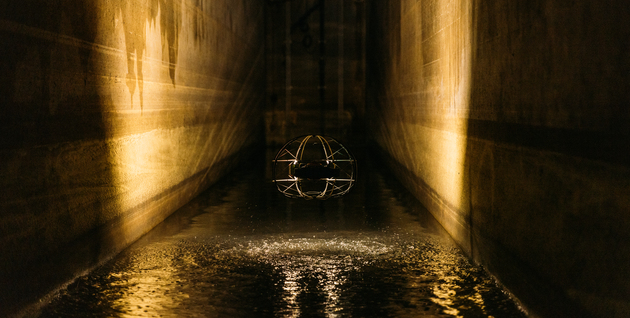Streamlining Sewer Inspections with Drones

© Flybotix.com
The United States relies on a vast and aging network of sewage infrastructure to support its population and protect public health. With more than 800,000 miles of public sewer lines and an additional 500,000 miles of privately owned connections, this critical system plays a vital role in transporting wastewater from homes, businesses, and industries to treatment facilities. Complementing this network are approximately 3.5 million miles of storm sewer lines, which manage runoff from rain and snowmelt. However, much of this infrastructure has exceeded its intended lifespan, leading to growing challenges such as frequent maintenance needs and an increased risk of system failures.
To prevent costly breakdowns and environmental hazards, sewage infrastructure is routinely inspected using a variety of methods. One of the most common techniques is closed-circuit television (CCTV) inspection, where a camera, either held manually or remotely on a tether, navigates through pipelines to capture real-time footage of structural issues like cracks, corrosion, or blockages. Additional tools include smoke and dye testing, procedures that introduce non-toxic materials into the system to identify leaks, faulty seals, or unauthorized connections.
As Vince Astorino, Operations Director at the Macomb County Public Works Office in Michigan, explains, these traditional inspection methods are often time-consuming, costly, and potentially dangerous for workers. Macomb County serves over 800,000 residents across 14 communities, with its extensive sewage infrastructure managed primarily by the Macomb Interceptor Drain Drainage District, the Martin Drain Drainage District, and the 8 1/2 Mile Relief Drain Drainage District. After years of relying on outdated technologies, the county has taken a major step forward by adopting drone-based inspection tools to modernize its approach.
In May 2024, the county approved funding for a new drone system specifically designed for sewer inspections. The ASIO X drone and its accompanying software platform, SewerAI, both developed by Swiss robotics company Flybotix, cost the county $100,000. In contrast, traditional manual inspections were costing nearly $1 million every three years. Weighing less than three pounds and encased in a protective polymer composite cage, the ASIO X is built for durability and safety in confined environments. It also features a 40,000-lumen adjustable lighting system, providing full visibility in even the darkest spaces.
Navigating a drone through narrow sewage lines with flowing water, poor lighting, and shifting airflows is no easy task. Although many emerging drone platforms operate through autonomous preplanned flights, the unique atmosphere of a sewage system necessitates that drones be manually operated. For that reason, Mr. Astorino relies on a highly trained pilot to guide the drone through these challenging conditions. “An antenna is lowered into the manhole to provide signal strength from the drone controller to the drone,” he explains. “The operator will fly the drone from one manhole to the next, recording video through that flight path.” With a flight time of just over 20 minutes, the ASIO X can cover up to 1,000 feet of pipeline, capturing visual data, LiDAR scans, thermal imaging, and gas readings all in a single flight.
Gathering this volume of data would previously have taken hours, if not days, and required significant time for in-field analysis. Ultimately, from the start of an inspection to the completion of data review, as much as a month could pass before any repairs could begin. With the Flybotix system, all data is securely and instantly transferred to the SewerAI software at the end of a flight, which uses artificial intelligence to automatically detect even the smallest defects. Although Flybotix guarantees a 10-day turnaround, Mr. Astorino reports that he typically receives a full inspection report within 24 hours.
As communities across the country confront the realities of deteriorating wastewater infrastructure, the urgency for modernization and strategic investment is mounting. Macomb County has emerged as a leader in applying drone technology to streamline sewer inspections. Currently, it is the only county in Michigan using drones in this capacity. After a year-long trial, expansion to other counties seems not only feasible but likely.
As Mr. Astorino put it, the difference between traditional and drone-based inspections is “like night and day,” saving the county substantial labor hours and taxpayer dollars. Macomb County’s innovative approach with drone technology offers a compelling blueprint for municipalities nationwide seeking smarter, safer, and more cost-effective infrastructure solutions.
|